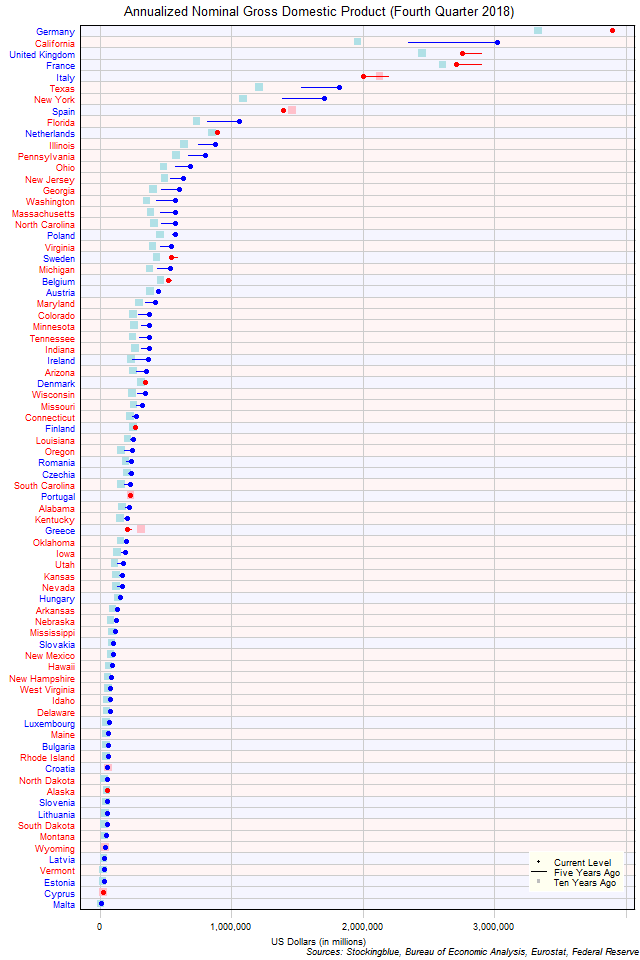
The chart above shows the annualized nominal gross domestic product (GDP) in each EU and US state as of the fourth quarter of 2018 in millions of US dollars, the change from five years ago, and the GDP ten years prior. Germany continues to be the largest economy but California is hot on its tail.
Findings
- The difference between the state with the largest GDP, Germany, and the state with the smallest, Malta, is $3,879,414 million (down from $3,896,723.14 million five years ago and up from $3,320,722 million ten years ago). Germany and Malta had the largest and smallest GDP respectively both five and ten years ago.
- Germany has 269.86 times the GDP that Malta does. The ratio of largest GDP to smallest GDP was down from 366.91 five years ago and down from 405.64 ten years ago.
- The median GDP in the 28 EU states is $239,320 million (up from $237,250 million five years ago and up from $237,340 ten years ago) and the mean $653,591 million (down from $667,888 five years ago and up from $603,204 ten years ago).
- The median GDP in the 50 US states is $238,726 million (up from $189,415 million five years ago and up from $167,163 ten years ago) and the mean $412,287 million (up from $337,057 five years ago and up from $287,295 ten years ago).
- The median GDP in the 78 EU and US states is $239,320 million (up from $221,845 million five years ago and up from $209,984 ten years ago) and the mean $498,909 million (up from $455,817 five years ago and up from $400,698 ten years ago).
- Sixty-four states saw their GDP rise in current dollars from five years ago (49 from the US and 15 from the EU) while 14 states saw their GDP drop in current dollars (one from the US and 13 from the EU).
- Seventy-one states saw their GDP rise in current dollars from ten years ago (49 from the US and 22 from the EU) while seven states saw their GDP drop in current dollars (one from the US and six from the EU).
- All EU drops in GDP with the exception of Greece's ten year drop are attributed to currency rate fluctuations.
Caveats
- Data is from the fourth quarter of 2018.
- The data is seasonally adjusted in current dollars.
- Euros are converted to dollars at an average exchange rate of 1.14 for the fourth quarter of 2018, 1.36 for the fourth quarter of 2013, and 1.32 for the fourth quarter of 2008 according to historic rates listed at the Federal Reserve (see source link below).
- US data comes in an annualized format which the EU does not, thus EU data is annualized by multiplying the quarterly figure by four.
- US growth rates may differ from those provided by the Bureau of Economic Analysis as the BEA's growth rates are based on chained dollars in conjunction with the chain index or the quality index for real GDP. The growth rates listed here are based on nominal GDP.
- All figures are rounded to the nearest hundredth.
Details
In absolute terms, France saw the largest decrease over the past five years with a drop of $188,277.28 million. California had the largest growth with a gain of $675,334.20 million. Over the past ten years, Italy had the largest decrease with a drop of $122,183.45 million while California had the greatest increase with a gain of $1,059,963.00 million.
In relative terms, Greece had the largest decrease over the past five years with a 12.07% drop in GDP while Ireland had the greatest increase with a 50.21% rise in GDP. Over the past ten years, Greece had the largest decrease with a 33.27% drop in GDP while Malta had the largest growth with a 75.82% rise in GDP.
There were 51 states (18 EU, 33 US) with a GDP of over $100,000 million ten years ago, 55 states (19 EU, 36 US) five years ago, and 56 states (19 EU, 37 US) now. On the flip side, there were 14 states (7 EU, 7 US) with a GDP of less than $50,000 million ten years ago, nine states (5 EU, 4 US) five years ago, and seven states (4 EU, 3 US) now.
Washington overcame the most states in the five year period going from having the 24th largest GDP to the 16th largest GDP. Conversely, Greece and Sweden were each surpassed by eight states in the five year period. Over the past ten years, Washington surpassed eight states, while Greece was surpassed by 20 going from the 25th largest economy in the EU and US to the 45th.
Sources
Federal Reserve. 2019. "Foreign Exchange Rates." Accessed May 26, 2019. https://www.federalreserve.gov/releases/g5/.
US Bureau of Economic Analysis. 2019. "GDP by State." Accessed May 22, 2019. https://www.bea.gov/data/gdp/gdp-state.